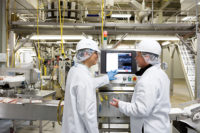Processors’ keen attention to food safety keeps hazards such as wood chips, glass, plastic and bones from entering the product stream. Attention to good manufacturing practices and preventive maintenance along with efforts to keep the physical hazards from entering the production environment are key, says Donna Schaffner, associate director of food safety, quality assurance and training for Rutgers Food Innovation Center, in Bridgeton, N.J. Screens, bone collectors, metal detectors and X-ray machines are used whenever possible.
“My clients are getting ready for the new FDA regulations and already adopting a more rigid system of monitoring, documenting and auditing those preventive controls, which will mitigate possibility of foreign material getting into finished product,” Schaffner says.
Cincinnati-based AdvancePierre Foods’ (APF) products undergo thousands of food safety-related tests and quality measurements daily to ensure it is delivering safe and quality foods. All APF plants have GFSI-audited quality systems and are SQF Level 3 Certified, validating that the proper policies and procedures are in place to address and prevent foreign materials from entering the process stream. Each facility uses a cross-functional team that documents and audits plant quality procedures to ensure compliance.
“APF has a multi-tiered approach that starts with our suppliers and is reinforced by double-pass X-ray systems for raw materials, rare-earth magnets, photo-eye sensors, in-line metal detectors and portable X-ray technology,” says Rick Bazzetta, director of quality at the company. “APF also has an innovative pallet-wrapping process, 100 percent inspection of raw material, a belt inspection program, foreign material assessments, sensory evaluations and in-line inspections. All of these preventive measures are bolstered by visual inspection from material receipt throughout the processing cycle.”
In addition, food safety and quality is the priority of every APF associate, and all associates are trained to identify foreign materials and their sources. For example, APF food plants have steering teams made up of management personnel and GFSI subject-matter experts responsible for implementing programs. Each plant conducts incoming audits of conveyances, pallets, raw materials, packaging, packing and all ingredients. As an integral part of APF’s foreign material prevention program, associates complete a comprehensive food safety training program and receive monthly refresher training.
“Visual inspection and awareness of foreign material by our team members is one of our best assets,” Bazzetta says.
Adherence to GMP policies and procedures and attention to details on the part of employees is required, Schaffner says. “Employees need to be trained to look for potential foreign material sources, and they need to be diligent in monitoring and inspecting processes and processing equipment as well as the general environment of the food processing facility,” she says. “They also need to have the importance of these things pointed out to them on a regular basis by management, and management needs to set the example of these behaviors by themselves being observant and immediately correcting any things they find on the floor or in the area which could become a source of foreign material in the product.”
Schaffner also recommends that all employees serve time on the company’s internal audit team, inspecting and auditing for potential sources of foreign material contamination as well as other GMP issues.
Proper equipment maintenance also can make a difference in keeping metal, wire, bolts and other pieces of metal out of the product stream.
“A well-designed preventive maintenance program includes inspection and replacement of wear-out parts before they actually breakdown to the point of having pieces fall off,” Schaffner says. “A detailed examination of all parts of the processing equipment and associated items will allow the maintenance personnel to find loose nuts, bolts and pieces of equipment before they have worked themselves completely off or completely loose from the body of the equipment. A detailed inspection of the equipment after any maintenance has been done should give the maintenance personnel the opportunity to see and remediate or remove any extra parts or pieces that might have been in the area of the work; replace covers, guards and shields; and tighten any loosened bolts or parts before the equipment is put back into operation.”
In addition, regular equipment maintenance, including lubrication of moving parts, will keep them operating smoothly for longer periods of time without binding up with rust, debris or having metal-on-metal contact that could generate metal shavings or broken pieces that might potentially fall into product, she says.
Proper preventive maintenance is critical to keeping equipment functioning as designed and alleviating the risk of breakage, Bazzetta says. APF’s comprehensive preventive maintenance program ensures equipment is kept in its properly functioning state, especially components under constant stress, such as belts.
“By adhering to manufacturers’ suggested maintenance frequency guidelines and executing APF’s policies and procedures, we prevent equipment deterioration and reduce potential physical hazards,” Bazzetta says.
X-ray and metal detection systems continue to play a critical role in detecting foreign material in the product stream as well. APF uses different combinations of metal detection, double pass X-ray technology, in-line X-ray technology, rare-earth magnets and portable X-ray technology.
“We continuously are exploring new technology and are undergoing testing of a new metal detection system at one of our plants,” Bazzetta says.
Bazzetta believes the further upstream in the production process that an X-ray or metal detection system can be placed, the better.
“Scanning raw materials before they are added to grinders or blenders inhibits foreign material from entering the processing phase of the operation, which is true prevention,” he says. “The use of X-ray technology and metal detectors at the end of a production process also is important to ensuring the delivery of safe and quality foods. Proper maintenance of these systems also is key.”
Schaffner says the obvious answer of where to place X-ray and metal detection devices would be at the last possible point where the product can go through detection equipment before leaving control. Typically that would mean sending the final packaged product through the metal detector or X-ray machine, but Schaffner points out that sometimes the final packaging interferes with detection devices. Paperboard cartons and corrugated cases manufactured with recycled material often contain traces of foil that will cause false positives at a metal detector or X-ray machine. It then becomes more effective and practical to send the product through a detection device before final packaging, Schaffner says.
Meat and poultry processors also might have certain operations within a process that are more likely to generate foreign material, and sometimes a detection device immediately after the source of the problem is appropriate, and can save damage to equipment later in the process.
“I would caution that placing the detection device too far from the final packaging, because it was more convenient to place it elsewhere, has led to failures and foreign material complaints many time in the past, so be careful,” Schaffner says.
Detecting foreign materials in the product stream is a never-ending endeavor that requires diligence, consistency and commitment.
“While material such as bone, which is inherent to the raw material, will always present challenges, multifaceted safety programs that start with supplier compliance are essential,” Bazzetta says. “We work closely with our suppliers to develop solutions to prevent foreign material in the product stream and to ensure consistent receipt of quality material.”
Perhaps the largest barrier to detection of foreign material is companies using equipment that is not capable of detecting all of the types of foreign material that can get into their product, Schaffner says. “Many companies rely on metal detectors, because they can be purchased for a lower cost than X-ray machines, and therefore fail to find and remove any of the other types of foreign materials such as wood splinters, bone, fruit pits, string, plastic or glass. Many equipment parts are constructed of plastics and non-metallic materials that are not detectable with a metal detector, and many non-metallic types of foreign material exist in the processing environment.”
X-ray equipment can find wire and very small particles of foreign material and can streamline many things, including fill-weights and imperfect package closures, but the cost for those more sophisticated pieces of equipment is still high, Schaffner says.
“The smaller food processors could most benefit from the multiple functions of that type of machine, but the smaller businesses are less likely to feel that they can afford the high initial investment,” she says. “If the cost of the equipment could be reduced, the technology would be utilized by many more companies.”
The next consideration for companies that have made the investment into X-ray equipment is validating that the equipment can find certain types of foreign material that might be very close in density to the food product. For example, for basic models of X-ray equipment, the orientation of long, thin pieces of material can allow it to pass through without detection, as often happens with wire, Schaffner says.
“The limit of detection of the particular piece of detection equipment might not be sufficient to find all of the materials that might get into the product to cause injury to a consumer,” she emphasizes.






Report Abusive Comment